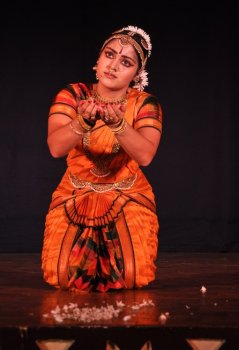
|   |

|   |
Rare outing for talented dancer - Jyothi Raghuram e-mail: jyothi.r.ram@gmail.com March 16, 2013 It was only her second major recital after her Rangapravesha about five years ago. Prior to this was the one at Vani Mahal in Chennai, during the dance festival of 2011. If one can recall from memory, her freely flowing facial expressions and polish in nritta were what lent optimism at her Rangapravesha. After this, it was as if Shreya Balaji went into a limbo, not being seen on stage.  Her recital at the ADA Rangamandira in Bangalore last week threw up a few surprises. For one, she has retained the freshness of face that was there at her debut recital, which was reflected in her enthusiasm, both being complementary to each other. Shreya has worked on and got rid of certain irritating mannerisms which marred her expressions. Best of all, her mukhija is now full-blown, making her heartfelt dance that much more enjoyable. If only this dancer could be seen more often on stage! Guru Revathi Narasimhan’s nattuvangam is a given at any show. This once, she was subdued and appeared a trifle tense, although she was not found wanting in her department. Those singing for dance need to strike a rapport with the dancer and involve themselves with her. Vocalist Bharathi Venugopal, although not a novice, has to sing from this perspective to pep up the dancer and give life to her own performance, contextually. When one talks of the format of adavus, different schools claim that their way of doing a certain adavu is of a kind. However, the basic structure has to remain the same. Shreya’s adavus fell short of credibility as her footwork did not sound out the syllables. One always likes to make mention of the refined nritta of this dance school, which was well carried out by Shreya, as in “Maathe,” the varnam in Kamach raga, and the tillana in Hindola. Sprightly swaras in “Gajavadana,” the Hamsadhwani Ganesha stuti , helped the recital take off in brisk fashion. Shreya’s subtlety of approach to the basic emotion of a composition was perceptible in the way she delivered the nritta in a devotional piece such as “Sriman Narayana” in Bhowli raga. Her thattu mettu was sharp yet gentle to go with the mood of the number. Her showing of “bhakti” was measured yet natural. “Natural” was what made Shreya’s facials so impressive. “Krishna Nee,” the Devaranama in Yaman Kalyani, was endearing, while “Arivenayya,” the padam in Athaana, vividly conveyed the anger of the nayika whose lover has strayed. The posture of a dancer defines her stage presence. Shreya has developed a tendency to sometimes slouch her shoulders when she bends forward or while dealing with the frontal muktayas. Musicians supporting her that evening were G Gurumurthy (mridangam), Dr. Nataraja Murthy (violin), and Narasimha Murthy (flute), who complemented Revathi Narasimhan. The stark stage backdrop was congenial for a solo Bharatanatyam, as it should always be. This was the authentic stage design of Chandrakumar Singh, whose lighting was as suitable for the individual show. Make-up by Kanakaraj was neat. Jyothi Raghuram is a journalist with over two decades experience in both the print and electronic media, having worked with news organizations such as PTI, The Hindu and Indian Express. Her specialized writings on the performing and visual arts have been considered as benchmarks for their comprehensive and in-depth dealing of the subjects. |